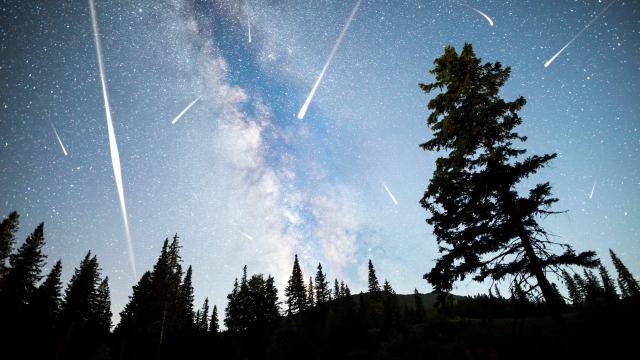There’s nothing better for cooling off during a punishingly hot summer than checking out the night sky, and this year, August is working overtime to entertain and entrance. Gaze upwards after dark this month, and you’ll be able to see the Perseids meteor shower, Saturn, a supermoon/blue moon, and more celestial delights.
Where and when to see the Perseids meteor shower
If you’re hoping to wish on a falling star, you’ll get a bunch of chances this month. The Perseids meteor shower that began in mid-July peaks on August 14 at 5:00 am AEST, when the earth passes through the thickest part of the trail of debris left behind by Comet 109/P Swift-Tuttle.
The 13th – 14th is the absolute peak of the Perseids, but you’ll be able to see a greater-than-average number of shooting stars on any night in August.
The Perseids should be particularly excellent this year. With only a sliver-sized waning crescent moon reflecting light, meteor peepers in dark places might be able to see up to 40 shooting stars an hour, particularly as it gets closer to dawn. Even suburban star-gazers in relatively light-polluted areas should be able to see about 10 meteors per hour, which is pretty amazing. For best results, go to as dark an area as you can with as wide and open a view of the sky as possible. (I’ll be in the middle of the ocean on the deck of my solid-gold yacht.)
Where and when to see August’s supermoon/blue moon
August’s second full moon is a blue moon and a supermoon. On Thursday, August 31, the blooper moon (as I call it) will be at its absolute peak.
This is the second full moon of the month—the first was on August 2—and that makes it a “blue moon.” It won’t look blue, but it will be exceptionally bright and large, hence the “supermoon” name. August’s full moon is the biggest and brightest of the year, and we won’t see a brighter full moon until November, 2025. So don’t miss it.
To find the full moon in the nighttime sky, look up at the sky and find the moon-shaped object reflecting a ton of light—no star-locating app is required.
Where and when to see Saturn in August 2023
Perseid meteors and the supermoon might be the stars of August’s night sky, but Saturn is a solid support player. While planetary mainstays Mars and Mercury spend most of the month drowned out by twilight, Saturn will be visible all month.
Saturn will be brightest from mid-August to mid-September, so you should be able to see it with your naked eye, but if you want to really take in those sexy, sexy rings, you’ll need binoculars or, better yet, a telescope.

Leave a Reply
You must be logged in to post a comment.